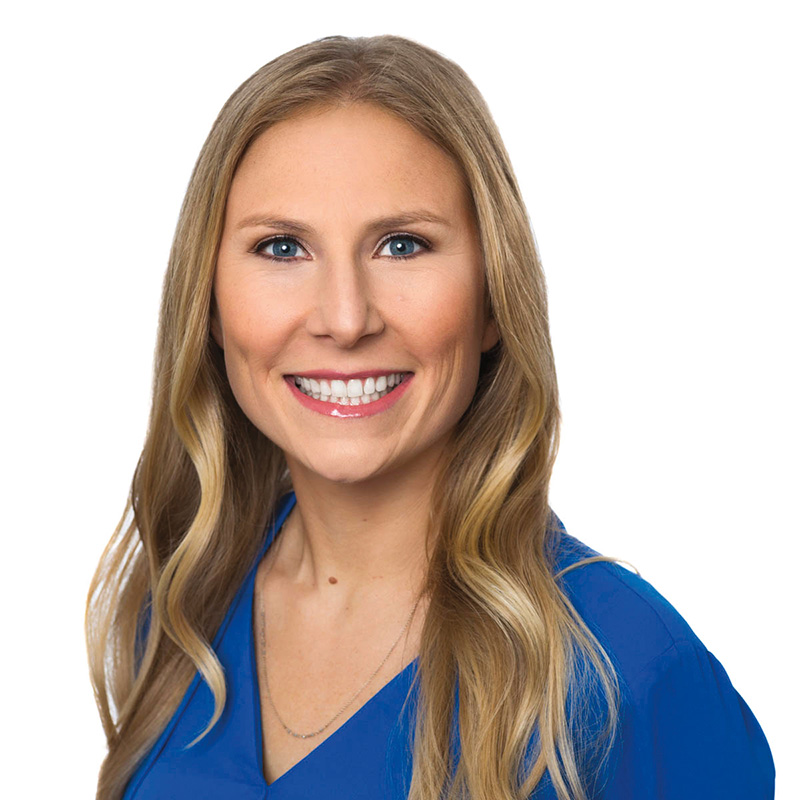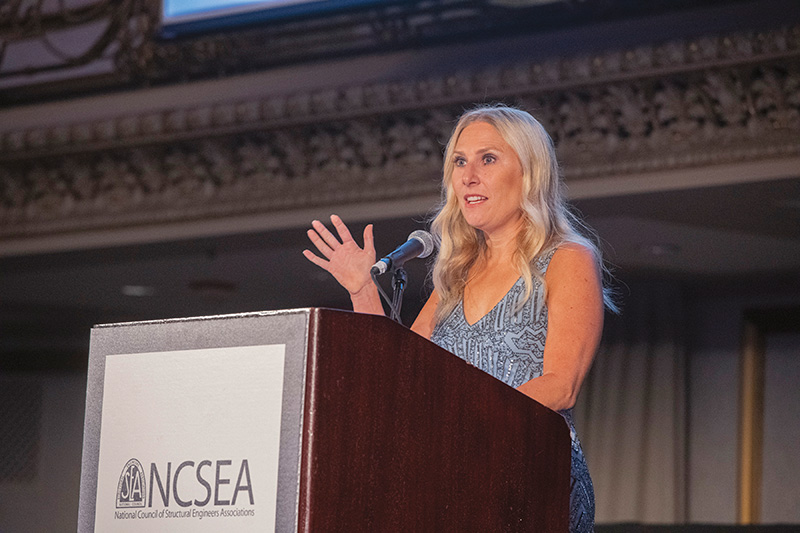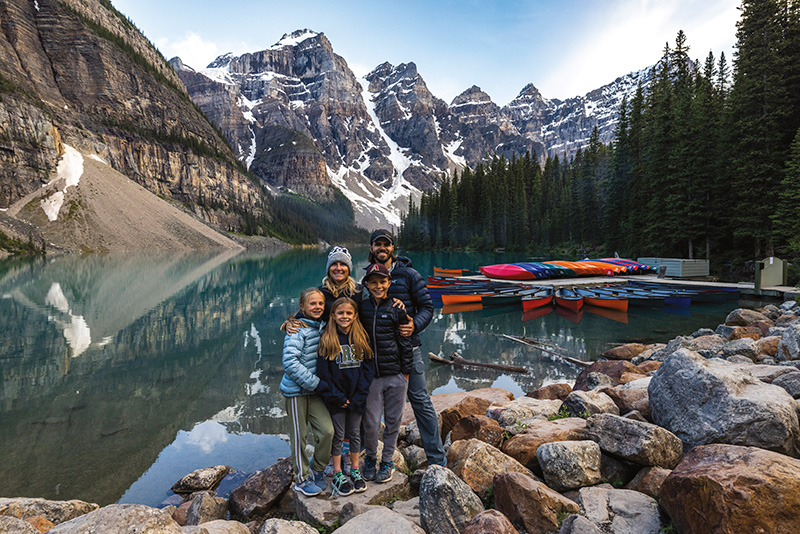Emily Guglielmo, is a Principal at Martin/Martin, Inc. and leader of the San Francisco Bay Area office.

She is Chair of the ASCE 7-28 Seismic Committee and is a voting member of the Wind and Main Committees. Emily is the chair of the National Council of Structural Engineers Associations (NCSEA) Code Advisory Committee. She has presented lectures on structural building code provisions nationally and internationally and was recognized with the Susan M. Frey NCSEA Educator Award. Emily currently serves on the boards of the Charles Pankow Foundation, the NCSEA Foundation, and the AISC Education Foundation. She is the President of the Structural Engineers Association of California (SEAOC) and served as the President of NCSEA in 2020-2021.
How did you become so involved in the development of codes and standards?
My journey into the world of code development can be traced back to a pivotal moment in my childhood. At the age of 8, I was a competitive gymnast, training for hours each day. One October evening, I was running down the vault runway when I was knocked off my feet. Sitting on the mat, I watched the lights sway, ultimately learning the San Andreas Fault had ruptured near the Loma Prieta peak. Witnessing the aftermath of collapsed roadways, bridges, and buildings, along with the realization of the significant loss of life, left a profound impact on my career choices.
As I pursued this career, I developed a deep passion for earthquake engineering, recognizing the critical role of robust seismic codes. However, as with many colleagues, the complexity of the codes frustrated me. When should an engineer apply the Ωo provisions, and why is Chapter 12 of ASCE 7 so convoluted? I do not believe in complaints without constructive participation. However, a path to contribution was elusive for me.
Several years later, my journey took a significant turn at a Structures Congress, for which I was a Young Professional scholarship recipient. During an early, chilly morning run around Lake Michigan, I had the privilege of meeting John Hooper, who held the position of Chair of ASCE 7 Seismic. From that day forward, John served as my mentor and advocate, facilitating my engagement in national code committee work.
While such work can be an exercise in patience, my participation has provided me with a deep understanding of technical topics, a mechanism to contribute to the improvement of our profession and communities and numerous lifelong friendships.
What do you think is the biggest misconception engineers have about the development of codes and standards?
One of the most common misconceptions among engineers is the belief that “codes are written by a bunch of academics who are just looking to get their research published.” In reality, the process of developing codes and standards requires numerous technical experts from diverse backgrounds, including practicing engineers, producers, academics, government representatives, and building officials.
Another prevalent misconception is that “the people who write codes just like to change things for the sake of change.” I know today this belief couldn’t be further from the truth. Those professionals who volunteer their time to update codes are genuinely committed to improving our profession.
While we are cautious about unnecessary change, we do carry the responsibility to advance our profession by consistently improving our codes. When compared to other industries, like technology and medicine, their embrace of innovation and change is integral to success. If our aim is to attain higher compensation or command greater respect, we must similarly embrace change, even if it entails mastering new aspects of our codes every six years.
I personally invite anyone who holds strong reservations about our codes to consider participating in a code committee meeting. You will find countless hard-working engineers giving their time and energy to improving our profession. Join us.
What advice would you give to young engineers?
My advice to young engineers is simple: Say Yes! In today’s world, where many advocate to “say no,” I believe that young engineers should seize every chance. There are countless opportunities specifically reserved for young engineers, from scholarships to designated committee positions. Take advantage of these prospects; step through each door and make connections.
Throughout my career, I’ve found that saying yes, especially when faced with challenging or intimidating situations, has resulted in new opportunities, meaningful relationships, and increased career satisfaction. Embrace the unknown, and don’t be afraid to stretch beyond your comfort zone.

How do you balance your volunteer engagement with your professional responsibilities and personal life?
Balancing volunteer engagement, professional responsibilities, and personal life is a continuous journey, and my approach has evolved. In the early days, I sought a strict work-life balance, often leaving me overwhelmed and perpetually unsuccessful. Instead, I’ve shifted this mindset. Rather than seeking balance, I focus on being content and present with my choices. I may choose to leave work early to coach a soccer game, but recognizing such a choice might result in an evening work session. I might miss a school concert, opting to attend an out-of-town committee meeting. At the end of the day, if I am satisfied with my choices and present in my activities, then I’ve found my balance.
What do you think is the biggest challenge facing our profession in the next ten years?
I believe that one of the most significant challenges (and opportunities) facing our profession in the next decade is the rapid advancement of Artificial Intelligence (AI). We stand at an inflection point and must make a choice to resist or strategically embrace AI’s disruptive potential.
In the next five years, AI is likely to replace many of the tasks we currently perform. Engineers who are unprepared to answer the question “what’s next” run the risk of being left behind. To ensure a meaningful future, we must actively explore new avenues for value creation. If we harness AI’s capabilities to handle monotonous tasks, it will liberate engineers to focus on innovation and creative problem-solving.

Who inspires you?
My three incredible kids. They are a constant source of inspiration, reminding me to be brave, to ask thought-provoking questions, and to approach each day with boundless energy. Their curiosity, resilience, and unwavering enthusiasm inspire me to be a better person.
What do you think you will be remembered for in terms of your personal legacy, and/or what are you most proud of?
I’m not preoccupied with a personal legacy, but I do hold a deep aspiration for the structural engineering profession that I will leave behind. I hope my contributions will contribute to a profession that is markedly more diverse and adaptable and seizes new opportunities.
Throughout my career, I’ve had the privilege of learning from others benefiting from the wisdom, energy, and innovations of those who came before me. I hope my efforts serve as a launching pad for future generations of engineers, propelling them to take structural engineering to new heights. My pride is in the enduring impact of my work on the future evolution of our profession.■
